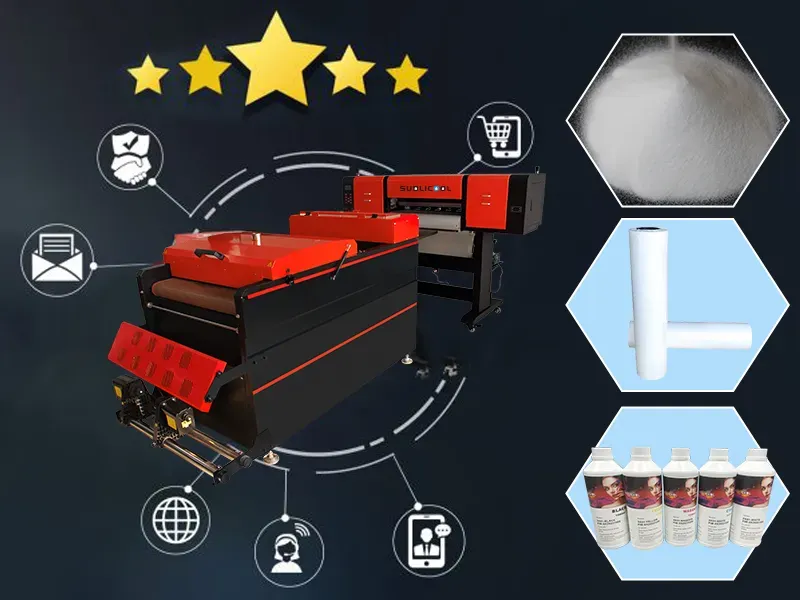DTF Technology, or Direct-to-Film printing, is revolutionizing the fabric design landscape, offering a modern solution for creating vibrant and intricate designs on textiles. Compared to traditional methods, DTF technology stands out by allowing for versatile applications on various fabric types, making it ideal for custom fabric design projects. This innovative printing technique not only delivers exceptional color accuracy but also aligns with the growing demand for sustainable fabric printing practices. With its cost-effective approach and reduced material waste, DTF printing benefits small businesses and designers looking to make their mark without incurring high expenses. As the industry continues to advance, embracing DTF technology is becoming essential for staying competitive in the evolving world of fabric design.
Direct-to-Film printing, also referred to as DTF printing, is rapidly gaining traction as a viable option for fabric design. This advanced technique allows artists and businesses to apply detailed designs directly onto a special film, which is then transferred onto a wide array of textiles. Not only does this method enhance the vibrancy and quality of prints, but it also supports environmentally friendly practices by reducing waste in comparison to conventional fabric printing approaches. Furthermore, the adaptability of DTF technology enables creators to explore an extensive range of materials, from cotton to synthetic blends, making it a perfect fit for custom fabric options. As demand for innovative, sustainable solutions grows, direct-to-film processes are shaping the future of textile creativity.
Understanding DTF Technology and Its Mechanism
Direct-to-Film (DTF) technology revolutionizes the printing landscape by allowing designs to be transferred onto fabrics in a swift and efficient manner. Unlike traditional methods such as screen printing that require multiple steps, DTF simplifies the process by printing designs on a special film which can be easily heat-pressed onto a variety of textiles. This technology caters not just to cotton, but also to synthetics like polyester, thus offering unprecedented versatility in fabric choice. The process also results in high vibrancy and durability, making it an essential method for custom fabric design.
The mechanism of DTF printing involves several critical steps. Initially, a design is printed onto a film using specialized inks that cater specifically to this method. Then, an adhesive is applied, allowing the design to firmly bond with the fabric upon heat application. This innovative approach has led to a new wave of opportunities in fabric design, where creators can experiment with intricate details and rich colors that were previously hard to achieve consistently. Such advancements are pushing the boundaries of what can be done within the fabric industry.
Benefits of DTF Printing vs Traditional Methods
One of the primary advantages of DTF technology is its cost-effectiveness. For small businesses and entrepreneurs, traditional printing methods often entail high setup costs and material waste, significantly affecting their profit margins. However, DTF printing facilitates low-volume orders without sacrificing quality or requiring immense financial resources upfront. This democratization of fabric printing empowers a wave of new designers and brands looking to make their mark in the industry without a heavy financial burden.
Additionally, DTF’s versatility extends its appeal beyond the cost savings. It provides the ability to print on both light and dark fabrics, further expanding the design possibilities for creators. Unlike some traditional methods that are limited by fabric color, DTF opens up a wider array of options, allowing for the creation of comprehensive and visually striking collections that captivate consumers. The adaptability provided by DTF printing is becoming increasingly crucial in a market that values uniqueness and custom fabric design.
Market Trends in DTF Technology Adoption
The trend towards adopting DTF technology is unmistakable, with a marked increase in sales of DTF printing equipment and supplies being reported across the industry. This surge indicates a shift among businesses towards more efficient, on-demand production methods that align well with current consumer expectations for customization and fast fulfillment. This growing interest reflects the broader changes in the fabric design marketplace, where agility and responsiveness to market trends are prioritized.
Furthermore, the rise of DTF technology is bolstered by the advancements in accompanying software that support the design phase. Software solutions specifically tailored for DTF printing enable designers to create highly detailed patterns and prints suited to the technology’s capabilities. This integration of user-friendly design tools enhances operational efficiency and creative potential, allowing brands to push the envelope in fabric design and meet the evolving demands of their target audiences.
Sustainability in DTF Fabric Printing
In today’s eco-conscious marketplace, sustainability is at the forefront of consumer preferences, and DTF technology is rising to the challenge with eco-friendly options. Many DTF systems now utilize environmentally-safe inks and materials, minimizing environmental impact without compromising the vibrancy and quality of the prints. By reducing waste typically associated with traditional methods, DTF aligns better with the green initiatives many brands strive to uphold, making it an attractive choice for companies seeking to enhance their sustainability credentials.
The integration of sustainable practices within DTF printing is not just beneficial for the environment; it also resonates with a growing demographic of consumers who prioritize eco-friendly products. As brands increasingly adopt green technologies, DTF provides a competitive advantage in a saturated market. Adopting this advanced printing method can not only improve a company’s carbon footprint, but also promote a positive brand image aligned with contemporary values of responsibility and innovation.
The Future of DTF Technology
As technology continues to progress, the future of DTF printing appears robust and laden with potential. Experts forecast that improvements in ink formulations and printing equipment will lead to faster printing speeds and even higher color accuracy. This growth comes in response to the demands of a rapidly evolving fashion landscape that requires quick turnarounds and adaptability across multiple fabric types, making DTF a pivotal player in future fabric innovations.
Moreover, the expansion of DTF beyond clothing into other domains such as home textiles and promotional products indicates a broadening scope for its applications. By leveraging the quality, efficiency, and customizability offered through DTF technology, businesses will likely find a myriad of opportunities to engage consumers and carve out unique niches in the market. The convergence of efficiency and creativity heralds a bright future for DTF in the fabric design sector.
Exploring Customization with DTF Printing
Customization is the heart of modern consumer demand, and DTF printing excels in this arena, allowing designers to create distinctly personalized fabric designs. The precision of DTF technology means that each piece can reflect individual aesthetics, from bold graphics to intricate textures, thus catering to the diverse preferences of today’s shoppers. With the rise of e-commerce and direct-to-consumer models, the capability to offer tailored designs has become a substantial competitive advantage.
Moreover, businesses can capitalize on the DTF technology’s versatile applications to diversify their product offerings significantly. Whether it’s custom apparel, accessories, or even home decor, the opportunities are limitless with DTF printing. This opens up exciting avenues for small and large brands alike, enabling them to respond quickly to market trends while delivering high-quality, personalized products that resonate with their audience.
Frequently Asked Questions
What is DTF technology in fabric design?
DTF technology, or Direct-to-Film printing, is an innovative fabric printing method that prints designs onto a special film, which is then heat-pressed onto various fabrics. This process allows for high-quality and vibrant prints that can be applied to a wide range of materials, making it a versatile choice for custom fabric design.
What are the main benefits of DTF printing compared to traditional fabric printing methods?
DTF printing offers several benefits over traditional methods, including cost-effectiveness, versatility, and improved print quality. It minimizes material waste and reduces setup costs, making it ideal for small batches. Additionally, DTF technology can print on both light and dark fabrics, expanding creative possibilities for designers.
How does DTF technology contribute to sustainable fabric printing?
DTF technology is aligned with sustainability trends in the fabric design industry by utilizing eco-friendly inks and materials that reduce environmental impact. This makes it a preferred choice for brands looking to enhance their eco-credentials while maintaining high-quality output in custom fabric designs.
Can DTF printing be used on various types of fabrics?
Yes, DTF printing is highly adaptable and can be used on a wide variety of fabrics, including cotton, polyester, and blends. This versatility enables designers to explore numerous applications in custom fabric design, making DTF an increasingly popular method in the textile industry.
What advancements have been made in DTF technology recently?
Recent advancements in DTF technology include improved inks and films that enhance color accuracy and print quality. These developments allow for more vibrant designs and detailed patterns, making DTF printing a favored method for custom creations and small-run garment production in the fabric design market.
What market trends are emerging with DTF technology in fabric design?
The market for DTF technology is experiencing significant growth, with increasing sales of DTF printing equipment and supplies. An integration of advanced design software tailored for DTF applications is also enhancing its appeal, making the design process more efficient and encouraging more businesses to adopt this innovative fabric printing method.
| Key Points | Details |
|---|---|
| What is DTF Technology? | Direct-to-Film printing involves printing a design onto a film that is then heat-pressed onto fabric, supporting various textiles and delivering high-quality results. |
| Advancements in Technology | Improvements in ink and film quality provide vibrant colors and detailed designs, enhancing the overall print quality. |
| Benefits Over Traditional Methods | DTF technology is cost-effective, reduces waste, and is versatile for applications on light and dark fabrics. |
| Market Trends | There is a growing interest in DTF technology, driven by increased sales of printing equipment and software integration for smoother design processes. |
| Sustainability | DTF technology incorporates eco-friendly materials, aligning with consumer demands for sustainable options. |
| Future Projections | Expectations for DTF technology include advancements in printing speeds, color accuracy, and sustainability, likely expanding its applications beyond apparel. |
Summary
DTF Technology is revolutionizing the fabric design industry by providing innovative, high-quality printing solutions that enhance creativity and efficiency. The shift towards Direct-to-Film printing not only offers cost-effective and versatile options but also aligns with the growing importance of sustainability in fashion. As we look towards the future, the continuous advancements in DTF technology promise to broaden its applications, solidifying its place as a key player in the evolving landscape of fabric design.



